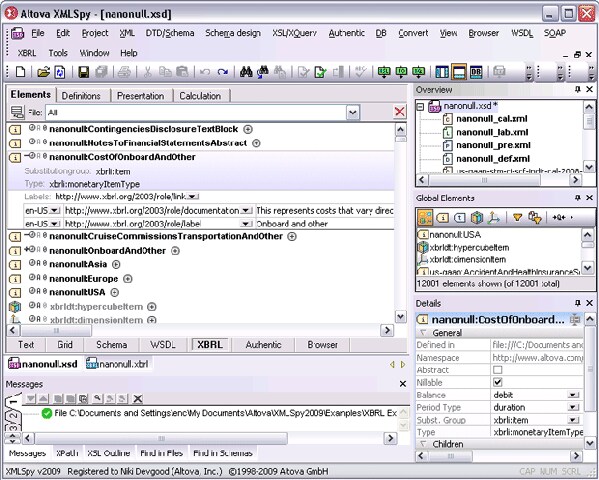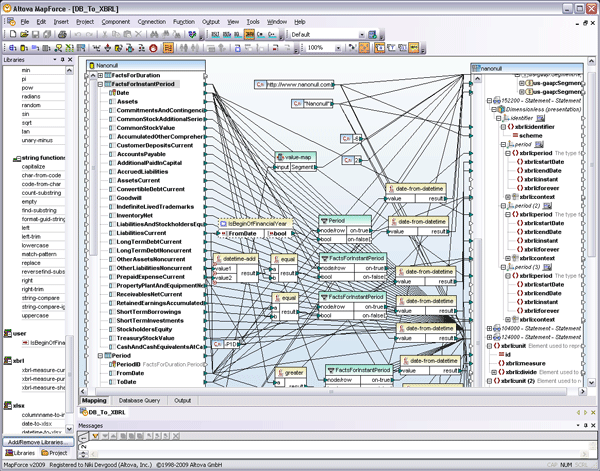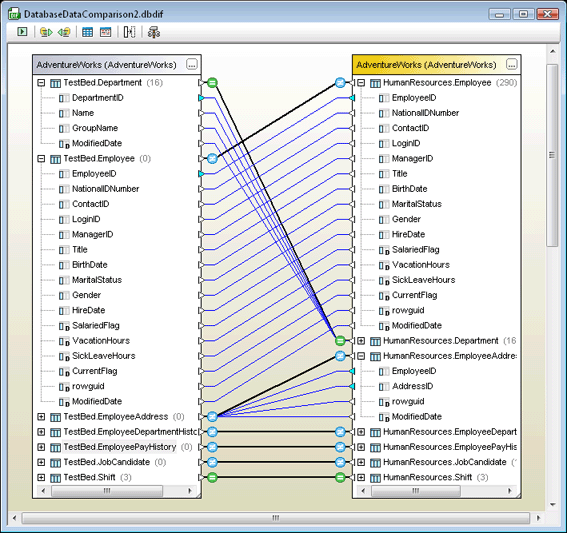Now available: Altova MissionKit Version 2009
We are very excited to announce general availability of the Altova MissionKit 2009 suite of XML, database, and UML tools. Version 2009 delivers numerous new features across the tools included in the MissionKit, including comprehensive support for working with XBRL, native support for new databases and database differencing, UML sequence diagram generation, and much more. A few details are below, with complete information and screenshots available on the Altova What’s New page. Coinciding with this major release, we have decided to pass savings realized due to the currently favorable US$/EUR exchange rate directly to our customers by reducing US$ prices across the entire Version 2009 product line.
Support for XBRL
The Altova MissionKit 2009 provides powerful new support for viewing, editing, validating, mapping, and publishing XBRL data. With intelligent wizards, graphical drag-and-drop design models, and various code generation capabilities, the MissionKit Version 2009 gives developers, technical professionals, and power users one easy-to-use suite of tools for working with XBRL and transforming data into content that can be shared with business partners, stakeholders, and regulatory commissions. Altova MissionKit tools with XBRL support are:
- XMLSpy 2009 – includes an XBRL validation engine that allows users to view and analyze XBRL taxonomies, as well as validate XBRL instance documents. XMLSpy 2009 also includes a graphical XBRL taxonomy editor, which provides a visual representation of XBRL taxonomies with intelligent views and entry helpers for editing and extending them.

- MapForce 2009 – supports graphical, drag-and-drop mapping of XBRL taxonomies as the source or target in any data mapping project. This new functionality enables users to comply with financial and business reporting mandates by graphically mapping backend data from accounting systems and databases to the XBRL format, or creating valid interim reports based on stored data. Users can map XBRL data to or from any other data format supported by MapForce, including XML, databases, flat files, Excel 2007 (OOXML), Web services, and EDI. This support is also useful for aggregating public XBRL data and mapping it to a database, for instance, for further analysis.

- StyleVision 2009 – Altova’s graphical stylesheet design tool now includes support for rendering XBRL data. This allows users to visually design financial reports for simultaneous output into HTML, RTF, PDF, and Word 2007 (OOXML) formats, enabling organizations to share customized business data in online or print format(s) with business partners, stakeholders, and regulatory commissions, all based on XBRL taxonomy requirements.
Extended Database Functionality
Native support for additional databases has been added to all database-enabled Altova MissionKit tools, including XMLSpy 2009, MapForce 2009, DatabaseSpy 2009, StyleVision 2009, and DiffDog 2009. Current support for SQL Server® and Oracle® databases is now extended to include the most recent versions – SQL Server 2008 and Oracle 11g. New support for the PostgreSQL 8 database is also now available. In addition, both DatabaseSpy 2009 and DiffDog 2009 now allow you to compare and merge database content. Individual database tables or multiple tables within a schema can be compared, whether they are the same database type or completely different databases. Results of the content comparisons are displayed in tables, and differences can be merged bi-directionally. This new database comparison functionality allows users to easily backup, copy, or merge data quickly and easily. 
Sequence Diagram Generation
MissionKit users working with UML will be especially interested in this new functionality in UModel 2009. Sequence diagram generation greatly assists developers who need to reverse engineer existing applications written in Java, C#, or Visual Basic. After importing an existing project, directory, or file into a UModel 2009 project, you can now select any operation in any class, and automatically generate a sequence diagram that illustrates the lifecycle of the operation, as well as objects that interact with it. Like all other project diagrams in UModel, sequence diagrams are stored as part of the UModel project file and can be included in generated UModel project documentation. Check out the full list of features added in Version 2009, and be sure to check back here frequently, as we’ll be blogging about more new features each week. As always, you can download a free trial of the Altova MissionKit to test out this new functionality for yourself.
